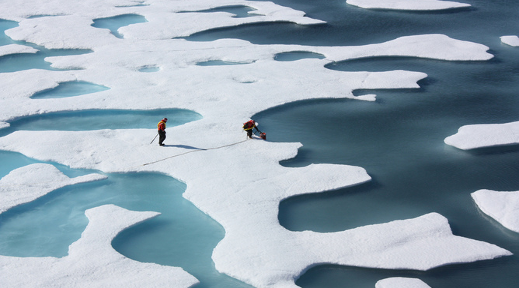The importance of the ‘pause’ in global temperatures has never been about whether some particular trend is just below or just above zero, or about whether a specific period shows a statistically significant trend (whatever that actually means), or even about whether the trend has changed. The ‘pause’ has always been about understanding whether Earth’s climate is evolving in line with our expectations. Continue reading Was there ever a 'pause'?
Category Archives: observations
An apples to apples comparison of global temperatures
When comparing global temperatures estimated from observations with climate model simulations it is necessary to compare ‘apples with apples’. Previous posts have discussed the issues of incomplete observational data, but a new paper by Cowtan et al. quantifies the influence of different observational data types. Continue reading An apples to apples comparison of global temperatures
Extremes of 2014 in review
Was last year really the warmest on record? As soon as NOAA published its official announcement in January, this question invaded the web feeding blogs, online newspapers and forums with passionate discussions. Relevant or pointless? The question is not so much knowing whether or not a new record was broken. Should 2014 rank second or third, this wouldn’t change the big picture: last year, temperatures on our planet continued the existing long-term positive trend. On top of that, the story is a bit thicker than the one single number obtained when averaging near-surface air temperatures in time and space. So, 2014: year of extremes or warm year in a changing climate?
Guest post by François Massonnet, Université Catholique de Louvain, Belgium / Catalan Institute of Climate Sciences, Spain Continue reading Extremes of 2014 in review
A spectrum of global temperature trends
Trends in global mean temperature are not static through time. Changes due to radiative forcings are influenced by internal climate variability. A recent paper by Karl et al. concluded that:
the central estimate for the rate of warming during the first 15 years of the 21st century is at least as great as the last half of the 20th century. These results do not support the notion of a “slowdown” in the increase of global surface temperature.
Are these conclusions, based on comparing a few periods, correct? Continue reading A spectrum of global temperature trends
How not to use daily CMIP5 data for impact studies
A new paper out this week in PLOS Biology uses some CMIP5 simulations of daily mean surface air temperature as part of a larger analysis on the change to future plant growing days. The description of the analysis suggests they have not used the simulations appropriately to arrive at their conclusions. Here I highlight a couple of possible pitfalls in using such data in impact studies. Continue reading How not to use daily CMIP5 data for impact studies
Global temperature comparisons
An update to the NOAA global temperature estimates has generated a lot of media excitement, based on a paper by Karl et al. in Science. How do the new estimates compare with other global temperature timeseries? Continue reading Global temperature comparisons
Extreme UK heatwaves
The largest impacts of increases in temperature will not be experienced due to changes in the mean, but by changes in the extremes. This is illustrated using UK heatwaves to show that the number of days which will require preventative action will increase by roughly a factor of 6 for a 2ºC increase in summer temperatures. Continue reading Extreme UK heatwaves

Arctic sea-ice decline erratic as expected
Imagine a ball bouncing down a bumpy hill. Gravity will ensure that the ball will head downwards. But, if the ball hits a bump at a certain angle it might move horizontally or even upwards for a time, before resuming its inevitable downward trajectory. This bouncing ball is an analogy for the behaviour of Arctic sea-ice.
Post based on Swart et al., Nature Climate Change, or see a less technical summary. Continue reading Arctic sea-ice decline erratic as expected